Effects of the Left Ventricular Mechanics on Left Ventricular-Aortic Interaction: Insights from Ex Vivo Beating Rat Heart Experiments
Abstract
1. Introduction
2. Materials and Methods
2.1. Animals
2.2. Echocardiography Images (ECHO)
2.3. Ex Vivo Beating Heart Experiments
2.3.1. System Preparation
2.3.2. Animal Preparation and Heart Dissection
2.3.3. Heart Cannulation
2.3.4. Data Collection
- Langendorff Perfusion:
- Working Heart Perfusion:
2.3.5. Data Analysis
3. Results
3.1. ECHO Analyses
3.2. Langendorff Perfusion
3.3. Working Heart Perfusion
4. Discussion
4.1. Left Ventricle Function
4.2. Aortic Function
4.3. Left Ventricle–Aorta Interaction
5. Conclusions
Author Contributions
Funding
Institutional Review Board Statement
Informed Consent Statement
Data Availability Statement
Conflicts of Interest
References
- Bell, V.; McCabe, E.L.; Larson, M.G.; Rong, J.; Merz, A.A.; Osypiuk, E.; Lehman, B.T.; Stantchev, P.; Aragam, J.; Benjamin, E.J.; et al. Relations between aortic stiffness and left ventricular mechanical function in the community. J. Am. Heart Assoc. 2017, 6, e004903. [Google Scholar] [CrossRef]
- Thompson, R.; Yacoub, M.; Ahmed, M.; Seabra-Gomes, R.; Rickards, A.; Towers, M.; London, F. Influence of Preoperative Left Ventricular Function on Results of Homograft Replacement of the Aortic Valve for Aortic Stenosis. Am. J. Cardiol. 1979, 43, 929–938. [Google Scholar] [CrossRef] [PubMed]
- Fukuda, N.; Sasaki, D.; Ishiwata, S.I.; Kurihara, S. Length Dependence of Tension Generation in Rat Skinned Cardiac Muscle Role of Titin in the Frank-Starling Mechanism of the Heart. Circulation 2001, 104, 1639–1645. [Google Scholar] [CrossRef]
- Mashima, H. MINIRE VIEW Force-velocity Relation and Contractility in Striated Muscles. Jpn. J. Physiol. 1984, 34, 1–7. [Google Scholar] [CrossRef] [PubMed]
- Loiselle, D.S.; Taberner, A.J.; Tran, K.; Han, J.C. Thermodynamic inconsistency disproves the Suga-Sagawa theory of cardiac energetics. Prog. Biophys. Mol. Biol. 2021, 164, 81–91. [Google Scholar] [CrossRef]
- Suga, H.; Sagawa, K. Instantaneous Pressure-Volume Relationships and Their Ratio in the Excised, Supported Canine Left Ventricle. Circ. Res. 1974, 35, 117–126. [Google Scholar] [CrossRef]
- Setser, R.; Henson Ii, R.E.; Allen, J.S.; Fischer, S.E.; Wickline, S.A.; Lorenz, C.H. Left Ventricular Contractility is Impaired Following Myocardial Infarction in the Pig and Rat: Assessment by the End Systolic Pressure-Volume Relation Using a Single-Beat Estimation Technique and Cine Magnetic Resonance Imaging. Ann. Biomed. Eng. 2000, 28, 484–494. [Google Scholar] [CrossRef]
- Tachibana, H.; Takaki, M.; Lee, S.; Ito, H.; Yamaguchi, H.; Suga, H. New mechanoenergetic evaluation of left ventricular contractility in in situ rat hearts. Am. J. Physiol. Circ. Physiol. 2025, 272, H2671–H2678. [Google Scholar] [CrossRef]
- Perlirri, S.; Soldà, P.L.; Piepoli, M.; Calciati, A.; Paro, M.; Marchetti, G.; Meno, F.; Finardi, G.; Bernardi, L. Time course of pressure and flow in ascending aorta during ejection. Int. J. Cardiol. 1991, 30, 169–179. [Google Scholar] [CrossRef]
- Mekkaoui, C.; Rolland, P.H.; Friggi, A.; Rasigni, M.; Mesana, T.G. Pressure-flow loops and instantaneous input impedance in the thoracic aorta: Another way to assess the effect of aortic bypass graft implantation on myocardial, brain, and subdiaphragmatic perfusion. J. Thorac. Cardiovasc. Surg. 2003, 125, 699–710. [Google Scholar] [CrossRef] [PubMed][Green Version]
- Ross, J., Jr. Point of view myocardial perfusion-contraction matching implications for coronary heart disease and hibernation. Circulation 1991, 83, 1076–1084. [Google Scholar] [CrossRef] [PubMed]
- Ross, J.; Braunwald, E. Studies on Starling’s Law of the Heart IX. The Effects of Impeding Venous Return on Performance of the Normal and Failing Human Left Ventricle. Circulation 1964, 30, 719–727. [Google Scholar] [CrossRef]
- Burkhoff, D.; De Tombe, P.P.; Hunter, W.C.; Kass, D.A.; Contractize, D.A.K. contractile strength and mechanical efficiency of left ventricle are enhanced by physiological afterload. Am. J. Physiol. Circ. Physiol. 1991, 260, H569–H578. [Google Scholar] [CrossRef]
- Fan, L.; Namani, R.; Choy, J.S.; Kassab, G.S.; Lee, L.C. Transmural Distribution of Coronary Perfusion and Myocardial Work Density Due to Alterations in Ventricular Loading, Geometry and Contractility. Front. Physiol. 2021, 12, 744855. [Google Scholar] [CrossRef]
- Fan, L.; Namani, R.; Choy, J.S.; Awakeem, Y.; Kassab, G.S.; Lee, L.C. Role of coronary flow regulation and cardiac-coronary coupling in mechanical dyssynchrony associated with right ventricular pacing. Am. J. Physiol. Hear. Circ. Physiol. 2021, 320, H1037–H1054. [Google Scholar] [CrossRef]
- Fan, L.; Namani, R.; Choy, S.; Kassab, G.S.; Lee, L.C. Effects of mechanical dyssynchrony on coronary flow: Insights from a computational model of coupled coronary perfusion with systemic circulation. Front. Physiol. 2020, 11, 915. [Google Scholar] [CrossRef]
- Schipke, J.D.; Stocks, I.; Sunderdiek, U.; Arnold, G. Effect of changes in aortic pressure and in coronary arterial pressure on left ventricular geometry and function Anrep vs. gardenhose effect. Basic Res. Cardiol. 1993, 88, 621–637. [Google Scholar] [CrossRef]
- Ichihara, K.; Neely, J.R.; Siehl, D.L.; Morgan, H.E. Utilization of leucine by working rat heart. Am. J. Physiol. Metab. 1980, 239, E430–E436. [Google Scholar] [CrossRef]
- Neto-Neves, E.M.; Frump, A.L.; Vayl, A.; Kline, J.A.; Lahm, T. Isolated heart model demonstrates evidence of contractile and diastolic dysfunction in right ventricles from rats with sugen/hypoxia-induced pulmonary hypertension. Physiol. Rep. 2017, 5, e13438. [Google Scholar] [CrossRef]
- Herr, D.J.; Aune, S.E.; Menick, D.R. Induction and assessment of ischemia-reperfusion injury in langendorffperfused rat hearts. J. Vis. Exp. 2015, 27, e52908. [Google Scholar] [CrossRef]
- Ashruf, J.F.; Ince, C.; Bruining, H.A. Regional ischemia in hypertrophic Langendorff-perfused rat hearts. Am. J. Physiol. Circ. Physiol. 1999, 277, H1532–H1539. [Google Scholar] [CrossRef][Green Version]
- Bell, R.M.; Mocanu, M.M.; Yellon, D.M. Retrograde heart perfusion: The Langendorff technique of isolated heart perfusion. J. Mol. Cell. Cardiol. 2011, 50, 940–950. [Google Scholar] [CrossRef]
- Fan, L.; Ziaei-Rad, V.; Bazil, J.; Lee, L.C. Connecting developed pressure-Preload relationship in ex-vivo beating heart with cellular sarcomere lengh-Tension relationship. J. Biomech. 2025, 183, 112597. [Google Scholar] [CrossRef]
- Akar, J.G.; Akar, F.G. Mapping arrhythmias in the failing heart: From Langendorff to patient. J. Electrocardiol. 2006, 39, S19–S23. [Google Scholar] [CrossRef]
- Headrick, J.P.; Peart, J.; Hack, B.; Flood, A.; Matherne, G.P. Functional properties and responses to ischaemia-reperfusion in Langendorff perfused mouse heart. Exp. Physiol. 2001, 86, 703–716. [Google Scholar] [CrossRef]
- DeWitt, E.S.; Black, K.J.; Kheir, J.N. Rodent working heart model for the study of myocardial performance and oxygen consumption. J. Vis. Exp. 2016, 16, e54149. [Google Scholar] [CrossRef]
- Reichelt, M.E.; Willems, L.; Hack, B.A.; Peart, J.N.; Headrick, J.P. Cardiac and coronary function in the Langendorff-perfused mouse heart model. Exp. Physiol. 2009, 94, 54–70. [Google Scholar] [CrossRef]
- Itter, G.; Jung, W.; Linz, W. The isolated working heart model in infarcted rat hearts. Lab. Anim. 2005, 39, 178–193. [Google Scholar] [CrossRef]
- Pigot, H.; Soltesz, K.; Paskevicius, A.; Liao, Q.; Sjöberg, T.; Steen, S. A novel nonlinear afterload for ex vivo heart evaluation: Porcine experimental results. Artif. Organs 2022, 46, 1794–1803. [Google Scholar] [CrossRef]
- Alavi, R.; Aghilinejad, A.; Wei, H.; Niroumandi, S.; Wieman, S.; Pahlevan, N.M. A coupled atrioventricular-aortic setup for invitro hemodynamic study of the systemic circulation: Design, fabrication, and physiological relevancy. PLoS ONE 2022, 17, e0267765. [Google Scholar] [CrossRef]
- Knight, W.E.; Ali, H.R.; Nakano, S.J.; Wilson, C.E.; Walker, L.A.; Woulfe, K.C. Ex vivo Methods for Measuring Cardiac Muscle Mechanical Properties. Front. Physiol. 2021, 11, 616996. [Google Scholar] [CrossRef]
- Eiby, Y.A.; Lumbers, E.R.; Headrick, J.P.; Lingwood, B.E. Left ventricular output and aortic blood flow in response to changes in preload and afterload in the preterm piglet heart. Am. J. Physiol. Regul. Integr. Comp. Physiol. 2012, 303, 769–777. [Google Scholar] [CrossRef] [PubMed]
- Usai, D.S.; Aasum, E.; Thomsen, M.B. The isolated, perfused working heart preparation of the mouse—Advantages and pitfalls. Acta Physiol. 2025, 241, e70023. [Google Scholar] [CrossRef] [PubMed]
- Müller-Strahl, G.; Hemker, J.; Zimmer, H.-G. Afterload-and preload-dependent interactions in the isolated biventricular working rat heart. Exp. Clin. Cardiol. 2002, 7, 180. [Google Scholar] [PubMed]
- Pappritz, K.; Grune, J.; Klein, O.; Hegemann, N.; Dong, F.; El-Shafeey, M.; Lin, J.; Kuebler, W.M.; Kintscher, U.; Tschöpe, C.; et al. Speckle-tracking echocardiography combined with imaging mass spectrometry assesses region-dependent alterations. Sci. Rep. 2020, 10, 3629. [Google Scholar] [CrossRef]
- Bardenheuer, H.; Schrader, J. Relationship between Myocardial Oxygen Consumption, Coronary Flow, and Adenosine Release in an Improved Isolated Working Heart Preparation of Guinea Pigs. Circ. Res. 1983, 52, 263–271. [Google Scholar] [CrossRef]
- Xin, L.; Yao, W.; Peng, Y.; Lu, P.; Ribeiro, R.; Wei, B.; Gellner, B.; Simmons, C.; Zu, J.; Sun, Y.; et al. Primed left ventricle heart perfusion creates physiological aortic pressure in porcine hearts. ASAIO J. 2020, 66, 55–63. [Google Scholar] [CrossRef]
- Larsen, T.S.; Belke, D.D.; Sas, R.; Giles, W.R.; Severson, D.L.; Lopaschuk, G.D.; Tyberg, J.V. The isolated working mouse heart: Methodological considerations. Pflug. Arch 1999, 437, 979–985. [Google Scholar] [CrossRef]
- Macgregor, D.C.; Covell, J.W.; Mahler, F.; Dilley, R.B.; Ross, J.; Relations, J.R. Relations between afterload, stroke volume, and descending limb of Starling’s curve. Am. J. Physiol. Content 1974, 227, 884–890. [Google Scholar] [CrossRef]
- Bittner, H.B.; Chen, E.P.; Peterseim, D.S.; Van Trigt, P. A Work-Performing Heart Preparation for Myocardial Performance Analysis in Murine Hearts. J. Surg. Res. 1996, 64, 57–62. [Google Scholar] [CrossRef]

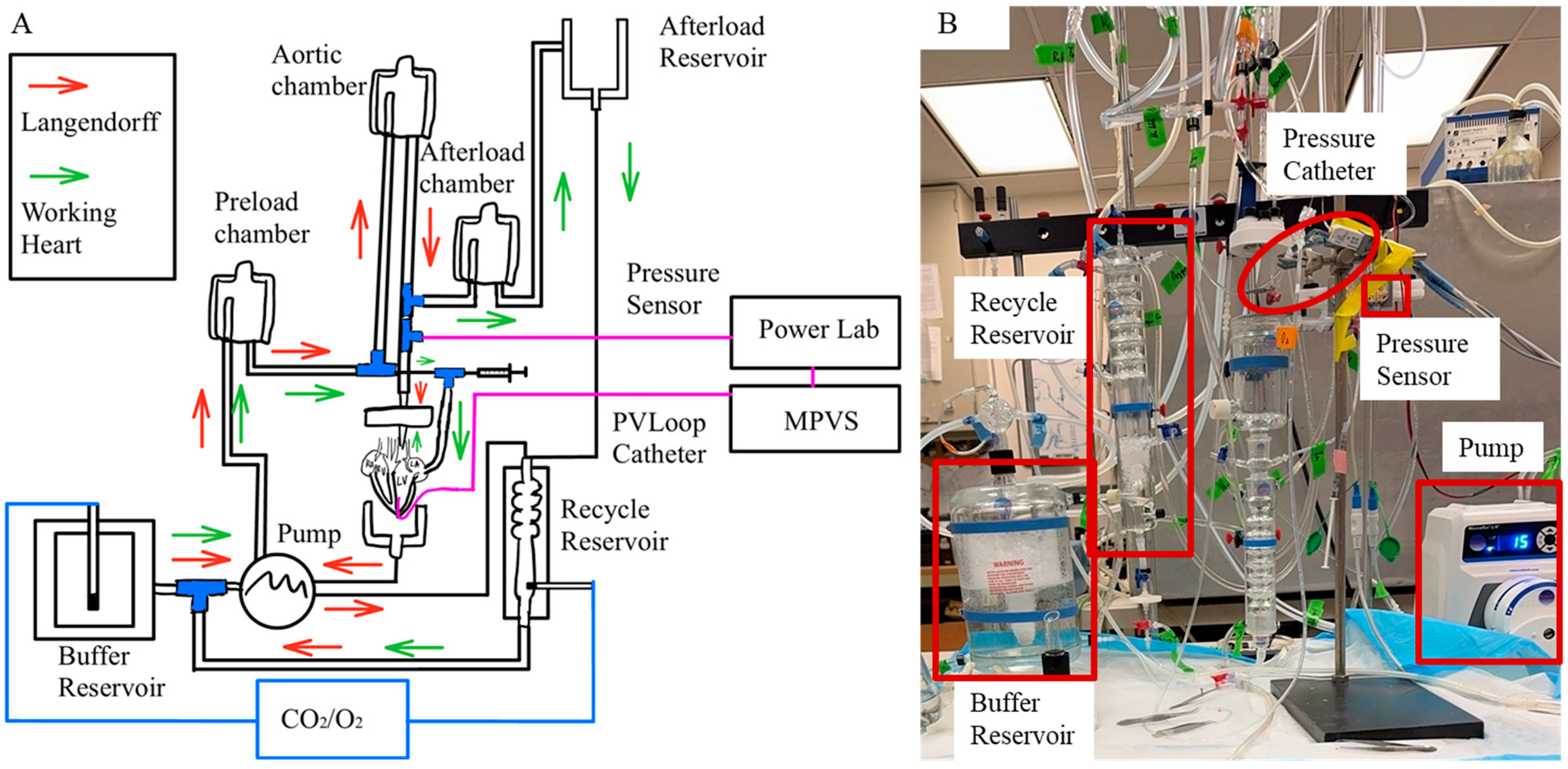
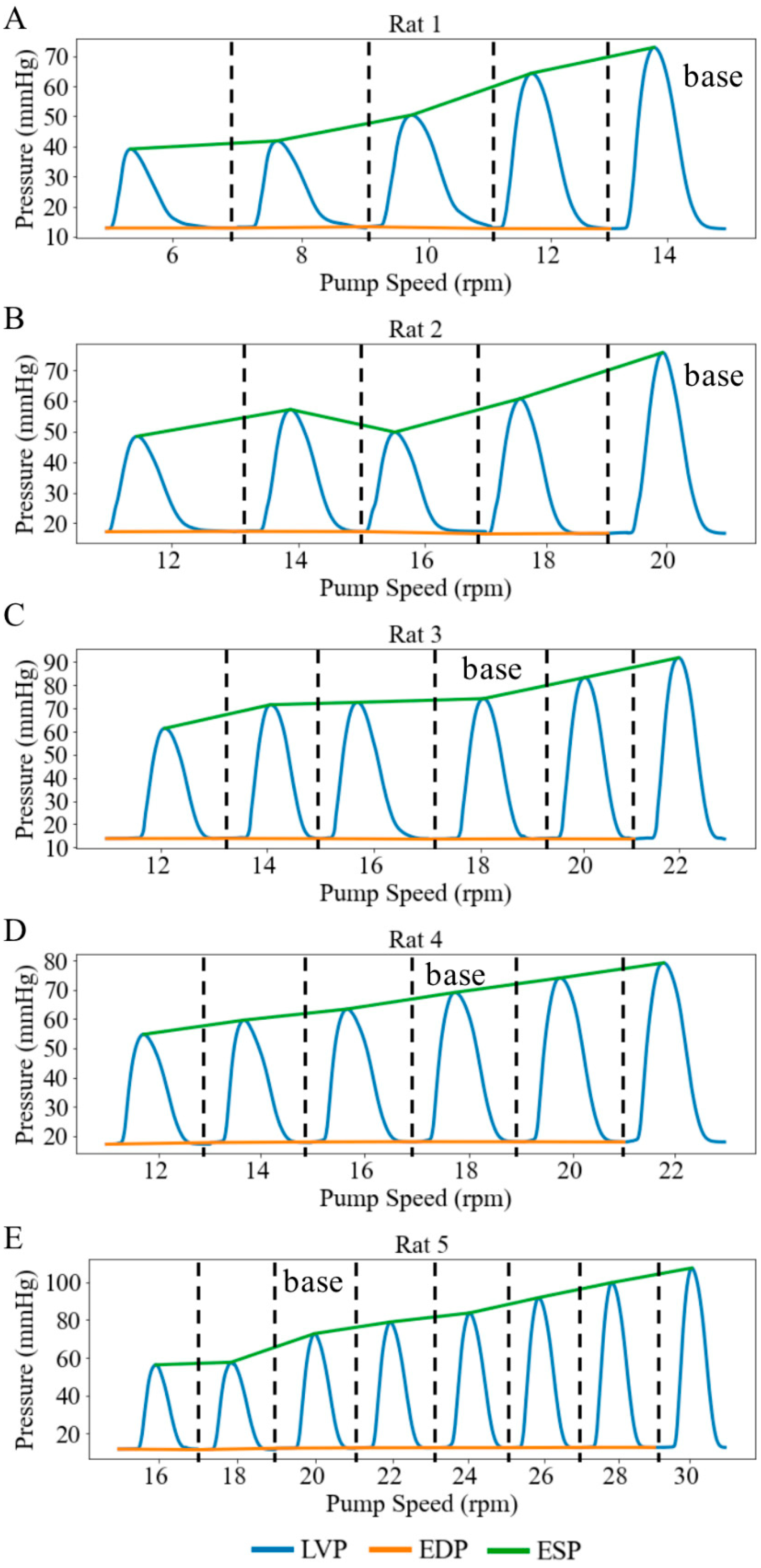
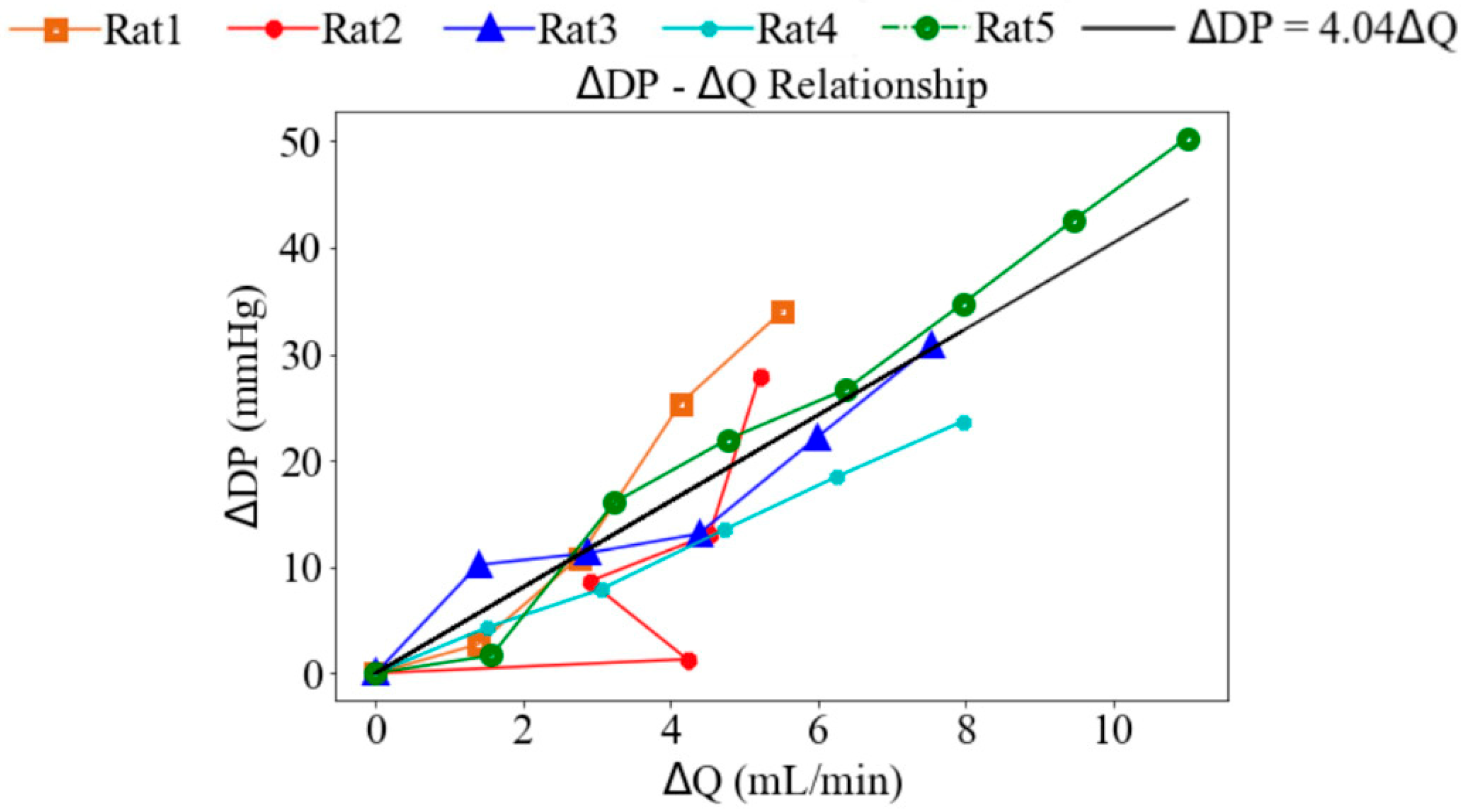

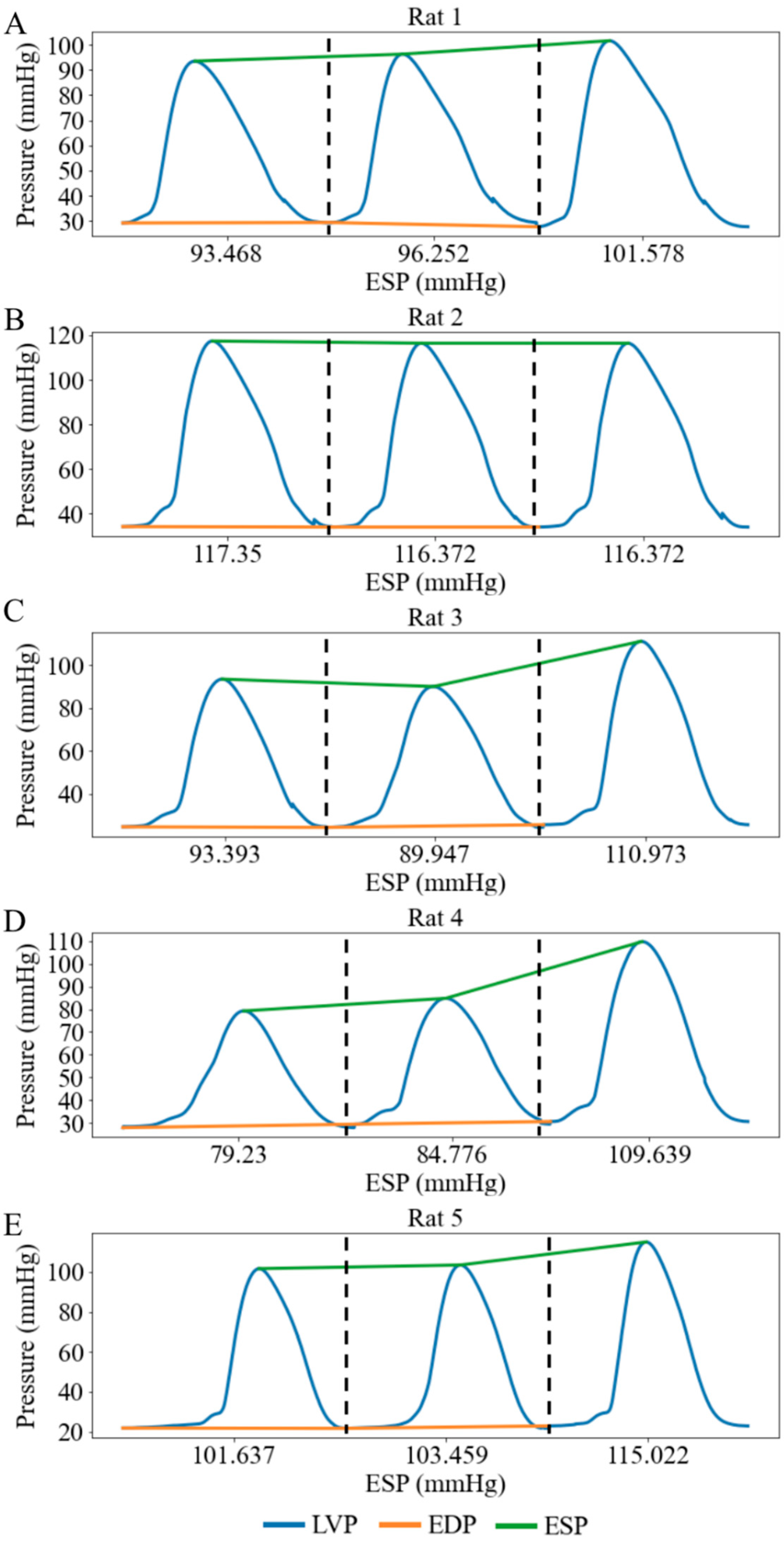
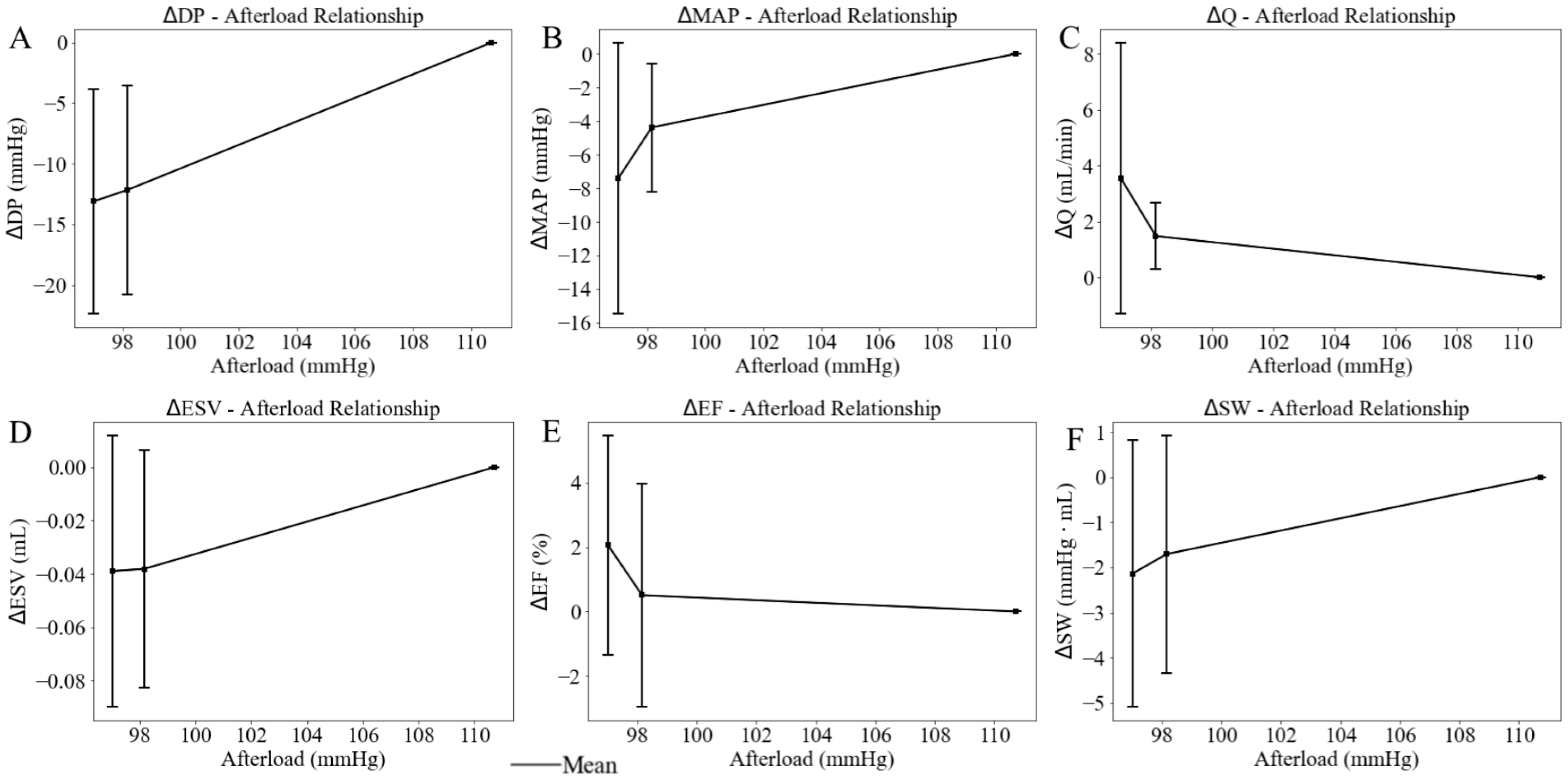

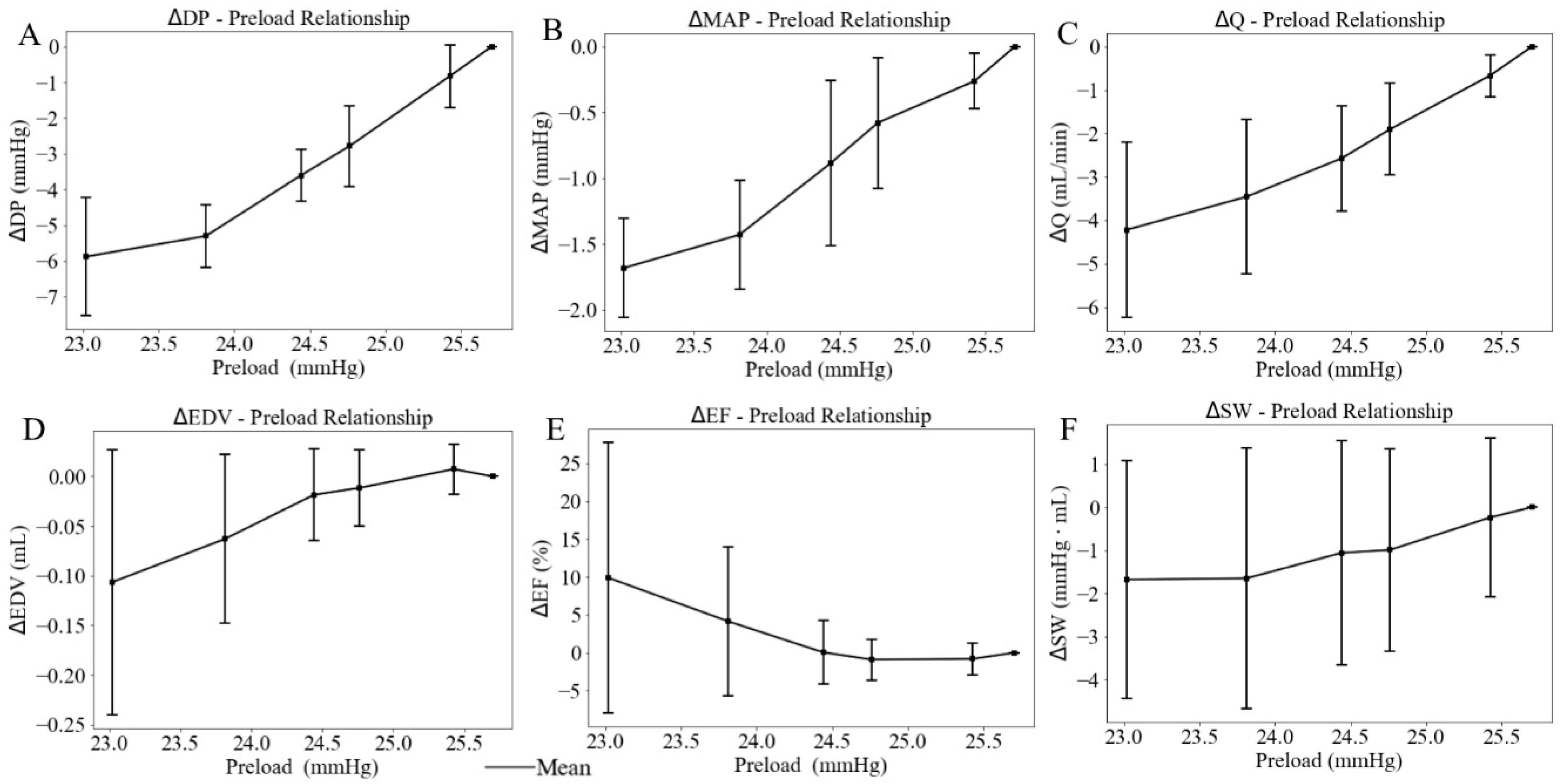
| Rat No. | EDV (mL) | ESV (mL) | SV (mL) | EF (%) | CO (mL/min) | GLS (%) | GCS (%) | HR (bpm) |
|---|---|---|---|---|---|---|---|---|
| 1 | 0.35 | 0.07 | 0.27 | 78.87 | 49.17 | −13.05 | −0.49 | 339 |
| 2 | 0.45 | 0.24 | 0.22 | 47.65 | 64.09 | −15.26 | −14.74 | 246 |
| 3 | 0.39 | 0.12 | 0.27 | 69.11 | 62.67 | −23.84 | −6.13 | 309 |
| 4 | 0.49 | 0.18 | 0.31 | 64.24 | 59.31 | −8.41 | −11.84 | 344 |
| 5 | 0.55 | 0.20 | 0.35 | 63.56 | 85.07 | −25.19 | −14.74 | 350 |
| Mean ± SD | 0.45 ± 0.08 | 0.16 ± 0.06 | 0.28 ± 0.05 | 64.69 ± 11.32 | 64.06 ± 13.11 | −17.15 ± 7.18 | −9.59 ± 6.18 | 317.60 ± 43.03 |
| Afterload | ESP (mmHg) | DP (mmHg) | MAP (mmHg) | Q (mL/min) | ESV (mL) | EF (%) | SW (mmHg∙mL) | PVA (mmHg∙mL) | HR (bpm) |
|---|---|---|---|---|---|---|---|---|---|
| 1 | 97.02 ± 12.46 | 69.45 ± 11.43 | 56.38 ± 11.57 | 6.04 ± 4.32 | 0.34 ± 0.17 | 36.72 ± 18.23 | 8.84 ± 2.13 | 7.07 ± 5.32 | 167 ± 20.56 |
| 2 | 98.16 ± 11.05 | 70.38 ± 10.39 | 59.4 ± 7.03 | 3.96 ± 2.65 | 0.34 ± 0.17 | 35.17 ± 18.81 | 9.27 ± 2.95 | 7.49 ± 5.46 | 172 ± 21.97 |
| 3 | 110.72 ± 5.20 | 82.54 ± 6.14 | 63.78 ± 6.04 | 2.49 ± 3.26 | 0.38 ± 0.19 | 34.66 ± 18.49 | 10.98 ± 4.06 | 9.08 ± 7.01 | 176 ± 25.60 |
| Preload | EDP (mmHg) | DP (mmHg) | MAP (mmHg) | Q (mL/min) | EDV (mL) | EF (%) | SW (mmHg∙mL) | PVA (mmHg∙mL) | HR (bpm) |
|---|---|---|---|---|---|---|---|---|---|
| 1 | 23.02 ± 4.27 | 91.03 ± 9.82 | 70.66 ± 1.13 | 5.34 ± 1.56 | 0.49 ± 0.13 | 52.57 ± 24.95 | 16.13 ± 5.02 | 13.39 ± 8.87 | 186 ± 33.68 |
| 2 | 23.81 ± 4.65 | 91.61 ± 9.25 | 70.91 ± 1.00 | 6.10 ± 1.25 | 0.53 ± 0.11 | 46.82 ± 18.81 | 16.16 ± 5.18 | 13.62 ± 8.70 | 191 ± 31.43 |
| 3 | 24.44 ± 4.64 | 93.31 ± 9.13 | 71.45 ± 1.10 | 6.99 ± 1.09 | 0.57 ± 0.12 | 42.73 ± 14.78 | 16.75 ± 5.07 | 15.08 ± 7.79 | 195 ± 29.11 |
| 4 | 24.76 ± 4.52 | 94.12 ± 9.55 | 71.76 ± 1.15 | 7.66 ± 0.94 | 0.58 ± 0.13 | 41.78 ± 13.73 | 16.82 ± 5.27 | 16.48 ± 7.30 | 198 ± 29.29 |
| 5 | 25.42 ± 4.37 | 96.08 ± 8.91 | 72.07 ± 1.03 | 8.90 ± 0.41 | 0.60 ± 0.13 | 41.87 ± 13.14 | 17.57 ± 5.22 | 18.42 ± 7.81 | 199 ± 29.45 |
| 6 | 25.70 ± 4.36 | 96.91 ± 8.96 | 72.34 ± 1.16 | 9.56 ± 0.74 | 0.59 ± 0.14 | 42.67 ± 11.74 | 17.81 ± 5.10 | 19.55 ± 6.94 | 196 ± 25.00 |
Disclaimer/Publisher’s Note: The statements, opinions and data contained in all publications are solely those of the individual author(s) and contributor(s) and not of MDPI and/or the editor(s). MDPI and/or the editor(s) disclaim responsibility for any injury to people or property resulting from any ideas, methods, instructions or products referred to in the content. |
© 2025 by the authors. Licensee MDPI, Basel, Switzerland. This article is an open access article distributed under the terms and conditions of the Creative Commons Attribution (CC BY) license (https://creativecommons.org/licenses/by/4.0/).
Share and Cite
Cai, C.; He, G.; Fan, L. Effects of the Left Ventricular Mechanics on Left Ventricular-Aortic Interaction: Insights from Ex Vivo Beating Rat Heart Experiments. Fluids 2025, 10, 234. https://doi.org/10.3390/fluids10090234
Cai C, He G, Fan L. Effects of the Left Ventricular Mechanics on Left Ventricular-Aortic Interaction: Insights from Ex Vivo Beating Rat Heart Experiments. Fluids. 2025; 10(9):234. https://doi.org/10.3390/fluids10090234
Chicago/Turabian StyleCai, Chenghan, Ge He, and Lei Fan. 2025. "Effects of the Left Ventricular Mechanics on Left Ventricular-Aortic Interaction: Insights from Ex Vivo Beating Rat Heart Experiments" Fluids 10, no. 9: 234. https://doi.org/10.3390/fluids10090234
APA StyleCai, C., He, G., & Fan, L. (2025). Effects of the Left Ventricular Mechanics on Left Ventricular-Aortic Interaction: Insights from Ex Vivo Beating Rat Heart Experiments. Fluids, 10(9), 234. https://doi.org/10.3390/fluids10090234







